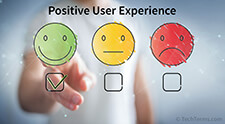User Experience
User experience, commonly abbreviated "UX," is the experience a person has using a product or service. In the technology world, this often refers to a hardware device or software program. A positive user experience is simple, intuitive, and enjoyable. A negative user experience is complex, confusing, and frustrating.
Successful companies focus on creating a high-quality user experience. When a user enjoys using a product, he or she is likely to continue using the product and may recommend it to other people. Conversely, if a product frustrates a user, he or she may switch to another product and tell others to avoid using it. Therefore, producing a positive user experience benefits both the company and the end user.
The focus of UX design is the user, rather than the product itself. The goal is to meet or exceed user expectations rather than to simply deliver a product. A product that provides a positive user experience is:
- functional
- intutive
- easy-to-use
- reliable
- enjoyable
Software UX
A software application that provides a good UX has an intuitive user interface. This means a typical user can learn the program by simply using it, rather than reading a manual or taking lessons. For example, a program with intuitive icons and simple menu bar options may be easy for a new user to understand. However, if a developer creates a program with non-standard icons and complex menu options, it will make the program less intuitive, likely resulting in a negative user experience.
Website UX
A website with a good UX is easy to view and simple to navigate. The font should be easy to read and the content should be clearly separated from any advertisements on the page. There should not be any unexpected popups or distracting animations on the page. The navigation should simple, which often includes a navigation bar at the top of the window as well as clear links within the content. Responsive design can help provide a good UX for both desktop and mobile users.
User experience is often associated with information technology, but it applies to all products. For example, automotive manufacturers strive to create a positive user experience for drivers. Retail stores aim to provide a positive user experience for customers. Since user needs and wants are constantly evolving, companies must listen and respond to user feedback. Successful companies continually update their products and services to meet customer expectations.
 Test Your Knowledge
Test Your Knowledge